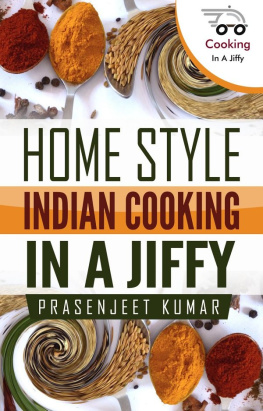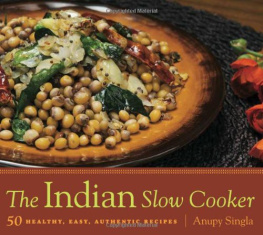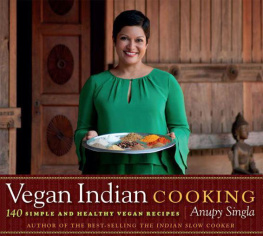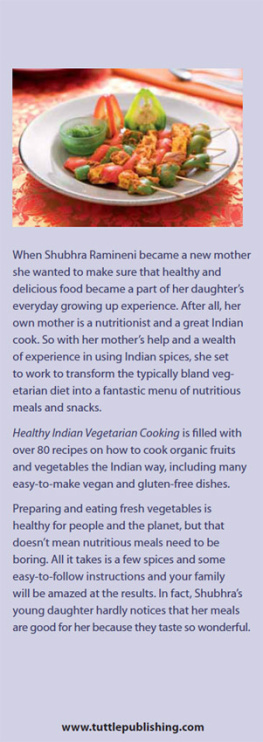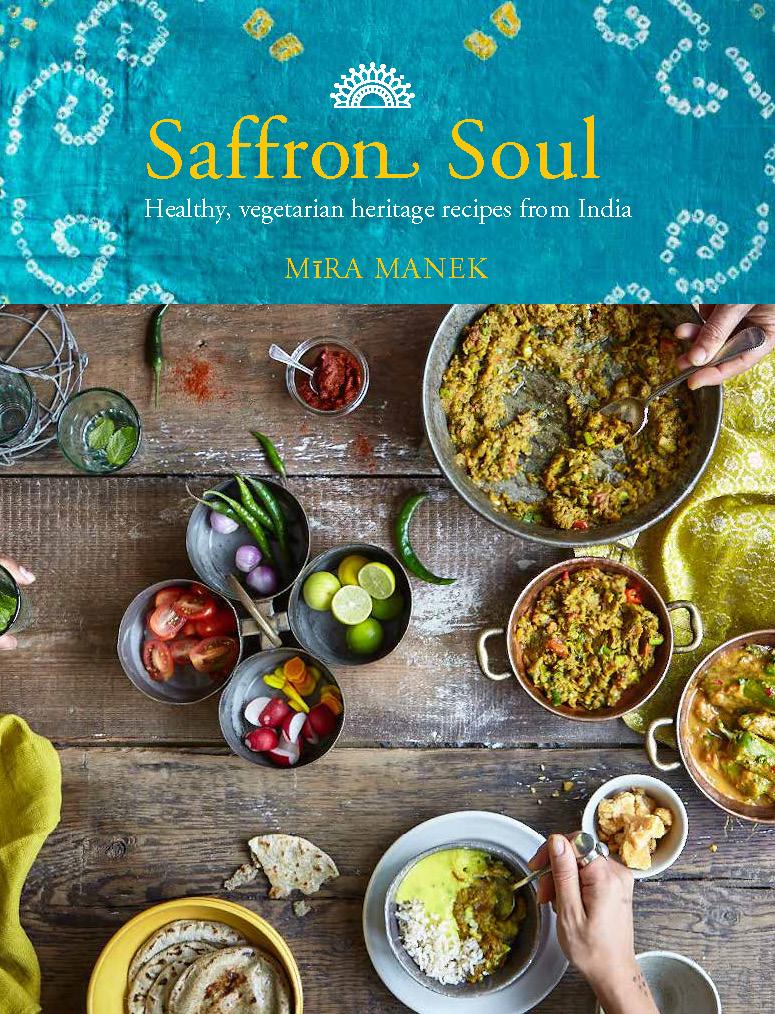Saffron Soul
Healthy vegetarian heritage recipes from India
MRA MANEK
Photography by Nassima Rothacker
First published in 2017 by
Jacqui Small LLP
7477 White Lion Street
London N1 9PF
QuartoKnows.com
Text copyright 2017 by Mra Manek
Photography, design and layout copyright Jacqui Small 2017
The authors moral rights have been asserted.
All rights reserved. No part of this book may be reproduced, stored in a retrieval system or transmitted, in any form or by any means, electronic, electrostatic, magnetic tape, mechanical, photocopying, recording or otherwise, without prior permission in writing from the publisher.
Publisher: Jacqui Small
Senior Commissioning Editor: Fritha Saunders
Managing Editor: Emma Heyworth-Dunn
Designer: Tania Gomez
Project Manager and Editor: Claire Wedderburn-Maxwell
Photographer: Nassima Rothacker
Additional photography shown here : Emily verland Dudlyke
Additional photography shown here : Ilaria Morelli
Props Stylist: Jennifer Haslam
Production: Maeve Healy
Digital edition: 978-1-91112-756-7
Hardcover edition: 978-1-91112-718-5
A catalogue record for this book is available from the British Library.
2019 2018 2017
Introduction
The seed was sown
I pulled out a small sachet of oddly shaped brown seeds and showed them to my grandmother. These are meant to lower cholesterol, I told her seriously (my father had been told to control his cholesterol levels). You can add them to curries, by which time she had pulled out a large jar of the very same seeds and was laughing away. We buy these for a few pounds and have been using them every day for years and years. How much did you get that for? she asked.
That was long before I knew anything about food, long before I had any digestion issues, long before I became fad-obsessed, yet I remember that moment as vividly as if it had happened yesterday. I recall meandering the streets of Covent Garden in London on a summers day, and walking into Neals Yard where the lady recommended those magic seeds called fenugreek, and my utter shock at the realization that my grandmother, mother and aunts used them daily.
It would follow on well to say that this moment inspired my love for health and cooking, but that, in fact, came some years later, sitting outside a caf enjoying a relaxing afternoon in Mumbai, India. Life-changing moments inspire shifts in perspective, introspection, even moving house or countries. For me, it was a passion. At the time, I had no idea that the notion of Indian food being healthy, which even for me was revolutionary, would open a whole world of possibilities and lead me in a new direction.
It was the years when I lived abroad and travelled that made me realize just how unique and special it was to be eating such simple, authentic and delicious Gujarati food every day. And so I set about learning traditional Indian recipes from my grandmother and mother. In doing so, I came up with my own creations, inspired by basic Indian principles, but using them in a different context, applying them to easy everyday cooking. I realized and am still discovering just how incredibly healthy, healing and versatile Indian spices are.
My misconceptions about healthy food
This book brings together the foods that I grew up with, and that I love to eat, albeit with my own adaptations. Both the discovery and rediscovery of this food really stems from my confused perception of what I believed to be healthy and low-fat, my obsession with losing weight and becoming skinny, my faithful sweet tooth I have struggled with, and from the constant digestion issues Ive always had.
Rediscovering home-cooked food again healthy and wholesome Gujarati dishes that I had always eaten as a child, and then shrugged off as a teenager, deeming oil the enemy and feeding my body with cereal bars and fad diets instead, has been extraordinary for me. And I dont use that word lightly when feeling fat or thin, bloated or light, dictates your mood and your day, you realize just how extraordinary it is to find and achieve a good balance, to finally figure out what being healthy means, and that nutrition and goodness should dictate your food. Essentially, I like making food that tastes really good and dishes that achieve this vital balance. Both are as important as each other.
Indian food can be healthy
Little did I realize that the perception I had of Indian food being unhealthy was and still is somewhat global. The common reaction when I mention healthy Indian food is: Is there such a thing? Well, yes, there is. And its all down to the ingredients and the way its cooked. The basic ingredients: the lentils, vegetables, grains and most importantly the spices, are all brimming with health benefits and, together, create a perfect balance. While I had been eating food made with all these spices on a daily basis growing up, I never realized or understood that their purpose is as much for nutrition as it is for flavour. However, it is the addition of excess cream, oil, sugar and colourings, along with the fried snacks we find at those quintessential Indian restaurants, that have defined our idea of Indian food.
Coming back to Indian food, returning home to my grandmothers Gujarati cuisine, looking at the thali with fresh and somewhat fascinated eyes, I have rekindled a connection. I have developed a new and better relationship with food, and I have found a new passion for experimenting with spices and different ingredients, creating beautiful food that is brimming with flavour and goodness.

The journey from Gujarat to Uganda to London
I wonder sometimes at the very nonchalant way my grandparents relay their stories of displacement, of growing up in Uganda and then being expelled from the country and moving, penniless, to London. Their struggles sound almost alien, yet at a time when news of refugees is so prime and poignant, I recall those stories with a sense of awe and astonishment. And then I think of my grandmother, whom we all call Bhabhi, whose story goes a few steps further: growing up in a village in Gujarat, India, with her maternal grandmother, who she always took to be her mother, then forced to move to Mombasa, Kenya, where her own parents lived, having never met them or her own siblings, and then being married to a man in Uganda, my grandfather, just two years later. That is just an element of her story. And food is a real part and parcel of this story, a real part of the movement or rather static suitcase of culture that a generation of Gujaratis took to Uganda once upon a time traditions, language and food which they unpacked in Uganda, then repacked in the very same way a generation later and brought to England.
India might have moved on, but the fashion, food and culture of the Ugandan British Indians remains very much the same as it once was all those years ago. A history that is both interesting and fascinating, that I want to capture in some way while my grandparents are very much a part of our day-to-day lives, stories that are simply stories now, but that they lived once upon a time, because of which we are all here, living the lives we live now.


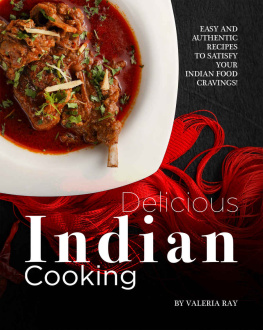
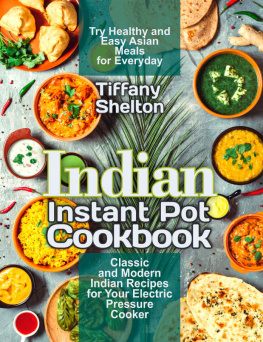
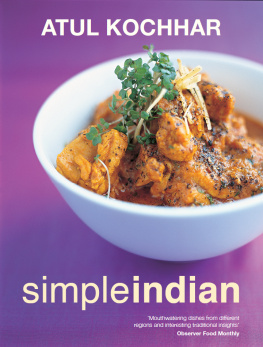
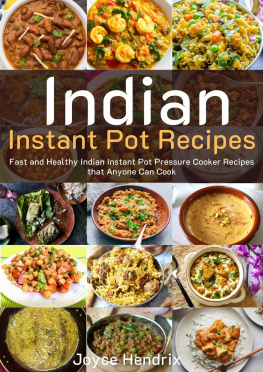
![Anita Jaisinghani - Masala: Recipes from India, the Land of Spices [A Cookbook]](/uploads/posts/book/320725/thumbs/anita-jaisinghani-masala-recipes-from-india-the.jpg)
